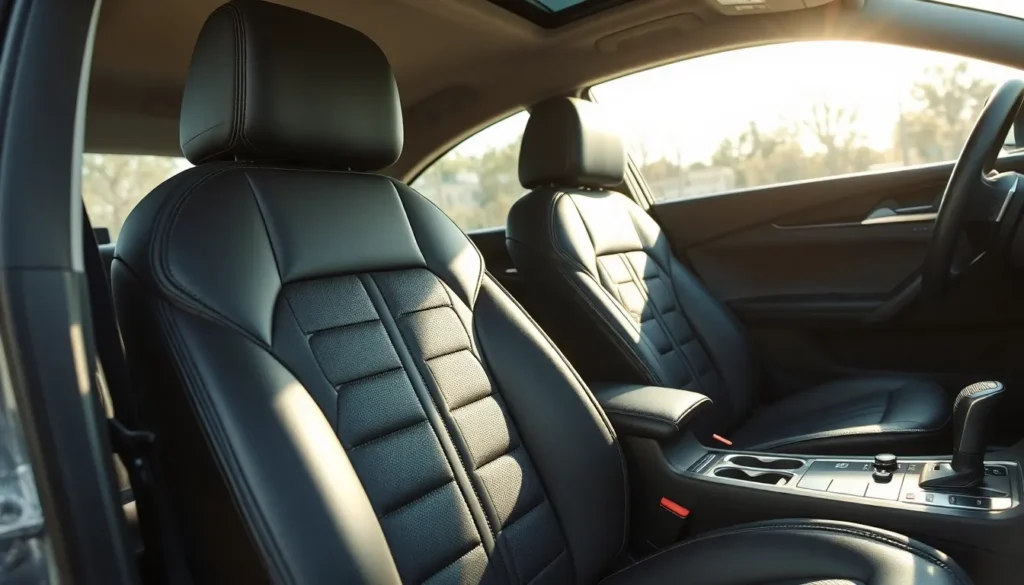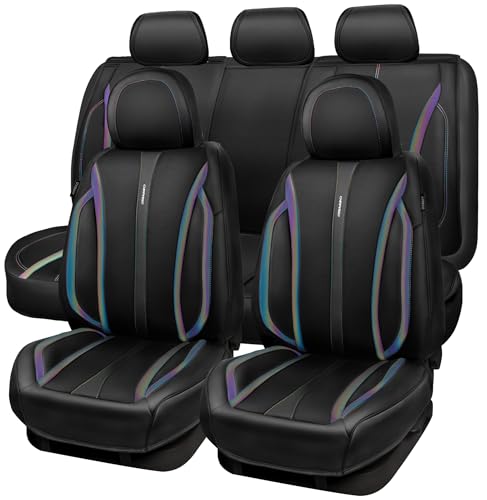Car seat covers aren’t just about protection anymore – they’re a powerful way to transform your vehicle’s interior and showcase your personal style. We’ve all experienced the frustration of worn-out original upholstery, spills that seem impossible to clean, and seats that just don’t match our vision for the perfect driving experience.
Today’s car seat cover designs go far beyond basic functionality. From luxurious leather-look materials to custom-printed patterns that reflect your personality, the options are virtually limitless. Whether you’re looking to protect expensive leather seats, cover up existing damage, or completely revamp your car’s aesthetic, the right seat cover design can make all the difference.
We’ll explore the latest trends in car seat cover design, materials that offer both durability and style, and how to choose covers that perfectly complement your vehicle’s interior. Get ready to discover how the right seat covers can turn your daily commute into a more comfortable and visually appealing experience.
Understanding Car Seat Cover Design Fundamentals
Car seat cover design fundamentals cover the critical elements that determine both functionality and aesthetic appeal. Mastering these core principles ensures we select covers that enhance our vehicle’s interior while providing lasting protection.
Material Selection and Durability
Material selection forms the backbone of effective car seat cover design. Neoprene offers waterproof protection and resists stains from spills and pet accidents. Leather provides premium aesthetics with natural durability that improves with age. Canvas materials deliver heavy-duty protection for work vehicles and outdoor enthusiasts. Polyester blends combine affordability with easy maintenance and color retention.
Durability testing reveals performance differences across materials. High-grade neoprene withstands 50,000 flex cycles without cracking. Genuine leather maintains structural integrity for 10-15 years with proper care. Canvas covers resist UV degradation for 5-7 years in direct sunlight. Synthetic materials offer 3-5 year lifespans under normal use conditions.
Construction methods impact longevity significantly. Double-stitched seams prevent tearing at stress points. Reinforced corners handle frequent entry and exit wear. Heat-sealed edges resist moisture penetration. Quality thread materials maintain seam integrity through temperature fluctuations.
Fit and Compatibility Considerations
Fit precision determines both appearance and functionality of car seat covers. Universal covers accommodate basic seat shapes but lack customized precision. Semi-custom options fit exact vehicle categories with improved contouring. Custom-fit covers match exact seat dimensions for seamless integration.
Compatibility factors extend beyond basic dimensions. Airbag deployment zones require specialized stitching patterns that separate during inflation. Power seat controls demand strategic cutouts for switch access. Heated seat compatibility requires perforated materials for heat transfer. Seat belt integration points need reinforced anchor attachments.
Installation complexity varies with fit type. Universal covers install in 15-20 minutes using elastic straps and hooks. Semi-custom designs require 30-45 minutes for proper positioning. Custom-fit covers demand 60-90 minutes for complete installation with all attachment points secured.
Measurement accuracy ensures optimal fit results. Seat width measurements include bolster dimensions for sport seats. Length calculations account for headrest height variations. Depth measurements consider seat cushion thickness differences. Side impact airbag locations require precise mapping for safety compliance.
Popular Car Seat Cover Design Styles

Car seat cover design styles range from practical universal options to sophisticated custom customized answers. Understanding these popular design approaches helps car owners select covers that match their exact needs and aesthetic preferences.
Universal vs Custom-Fit Designs
Universal car seat covers provide affordable protection for a wide variety of vehicle models. These designs feature adjustable straps and elastic sections that accommodate different seat shapes and sizes. Standard universal covers cost between $25-75 per set and fit approximately 80% of vehicle seats effectively.
Custom fit designs create precise coverage customized to exact vehicle makes and models. Manufacturers use exact seat measurements to produce covers that conform to every contour and feature of original upholstery. Custom covers typically cost $150-400 per set but deliver superior appearance and protection compared to universal alternatives.
Installation complexity differs significantly between these two design approaches. Universal covers require 15-30 minutes for complete installation using basic tools and adjustment techniques. Custom designs often install in 5-10 minutes due to their precise fit specifications and streamlined attachment systems.
Color and Pattern Options
Solid color car seat covers dominate the market with black gray and beige representing 70% of consumer purchases. These neutral tones complement existing interior colors while maintaining resale value considerations. Bold colors like red blue and tan account for approximately 20% of selections among style conscious buyers.
Pattern designs include geometric prints animal textures and sport team logos that reflect personal interests. Camouflage patterns attract outdoor enthusiasts while racing stripes appeal to performance car owners. Abstract designs and artistic prints represent emerging trends in contemporary automotive fashion.
Two tone combinations create visual interest through contrasting colors on different seat sections. Popular combinations include black with red accents gray with blue trim and tan with brown highlights. These designs add sophistication without overwhelming the vehicle’s existing interior elements.
Luxury and Premium Designs
Genuine leather car seat covers represent the premium standard for luxury vehicle interiors. Top grain leather costs $300-800 per set and provides exceptional durability with proper maintenance routines. Perforated leather designs enhance breathability while maintaining the sophisticated appearance that luxury car owners expect.
Diamond quilted patterns create upscale texture through precise stitching techniques. These designs feature geometric patterns with padded sections that provide additional comfort and visual appeal. Quilted covers typically cost $200-500 depending on material quality and construction complexity.
Carbon fiber accents and metallic threading add modern luxury elements to contemporary seat cover designs. These features complement high tech vehicle interiors while providing unique aesthetic details. Premium synthetic materials now replicate genuine leather appearance at 40-60% lower costs making luxury styling accessible to broader consumer segments.
Functional Design Features
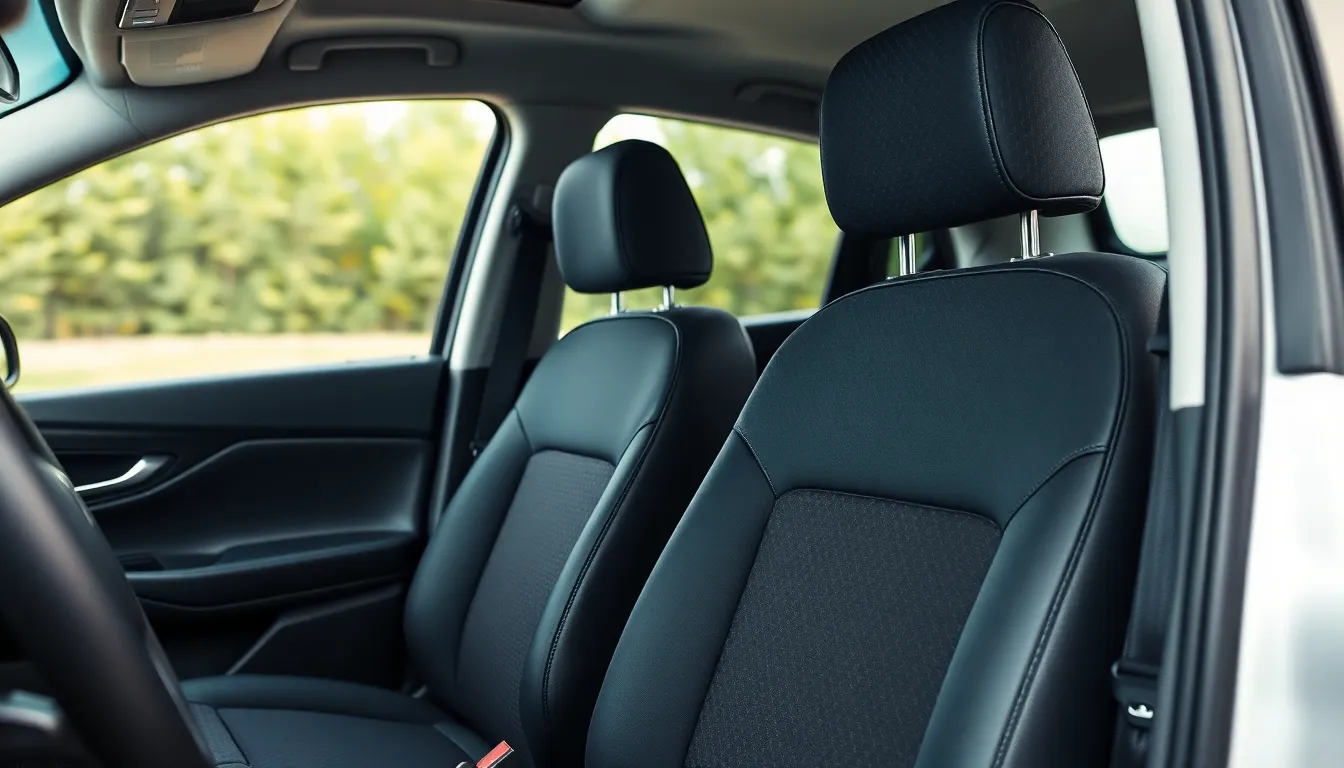
Functional design features transform car seat covers from simple protective accessories into comprehensive interior enhancement answers. Modern seat cover designs integrate safety requirements with practical convenience elements to maximize usability and performance.
Airbag Compatibility
Airbag compatibility represents the most critical safety consideration in car seat cover design. We find that compatible covers feature strategically placed breakaway stitching that allows airbags to deploy properly during impact situations. Side impact airbags require covers with exact tear-away seams along the outboard edges of seat backs where airbag modules are located.
Premium manufacturers test their covers with automotive safety standards including FMVSS 208 regulations to ensure proper deployment timing. Compatible designs use special stitching patterns that break under 25-30 pounds of force, allowing airbags to emerge within the required 20-30 millisecond timeframe. Non-compatible covers create dangerous barriers that can redirect airbag deployment angles or delay inflation timing by up to 15 milliseconds.
Certification markings on compatible covers include “Airbag Safe” or “Side Impact Compatible” labels that indicate successful testing completion. We recommend verifying compatibility with your vehicle’s exact airbag configuration before purchasing any seat cover system.
Easy Installation Systems
Installation systems determine the practical usability of car seat covers for average consumers. Quick-fit designs use elastic strapping systems that secure covers without removing seats from vehicles. Hook and loop fasteners create adjustable attachment points that accommodate various seat shapes and sizes.
Buckle systems provide the most secure installation method, using plastic or metal buckles that connect under seat cushions. These systems typically require 15-20 minutes for complete installation compared to 45-60 minutes for traditional tie-down methods. Slip-on designs offer the fastest installation at 5-10 minutes per seat but provide less secure fitting around seat contours.
Professional installation kits include specialized tools like seat gap wedges and tucking implements that ensure proper fitting around seat creases. Some premium covers feature integrated installation guides printed directly on the cover material to streamline the fitting process.
Storage Pockets and Accessories
Storage integration expands the functional capacity of car seat covers beyond basic protection. Map pockets attach to seat backs and accommodate documents, tablets, or small personal items. These pockets typically measure 8×12 inches and feature elastic tops to secure contents during vehicle movement.
Organizer panels include multiple compartment configurations with pen holders, phone slots, and beverage holders built into the cover design. Multi-pocket systems can add up to 6 additional storage spaces per seat without compromising cover fit or appearance. Some designs incorporate clear plastic windows for easy identification of stored items.
Accessory compatibility includes mounting points for tablet holders, charging cable management systems, and removable cooler inserts. Premium covers offer modular accessory systems where storage components can be added or repositioned based on individual user requirements.
Material Performance and Comfort
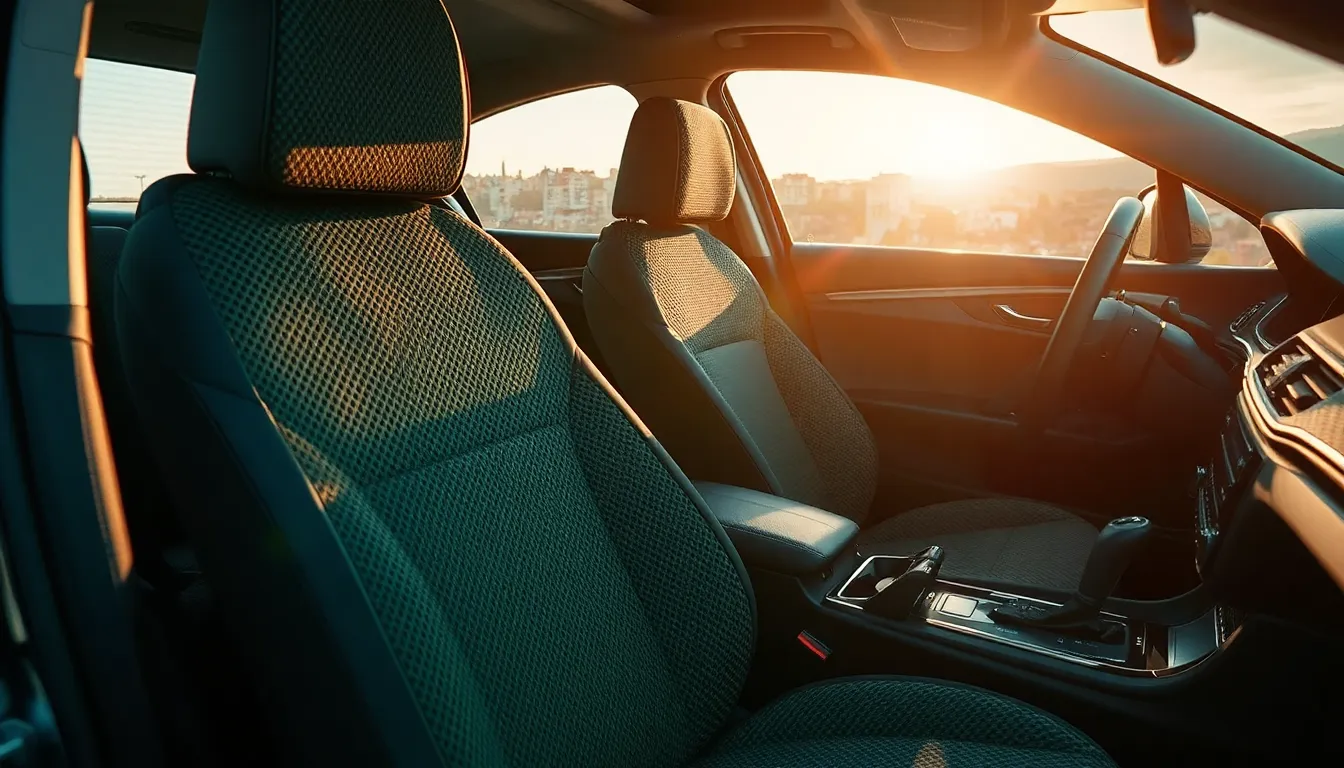
Material performance directly impacts daily driving comfort and long-term satisfaction with car seat covers. We evaluate fabric characteristics that affect user experience across different driving conditions and seasons.
Breathability and Temperature Control
Breathability determines how well air circulates through car seat cover materials during extended driving periods. Mesh fabric panels in covers allow airflow rates of 200-300 cubic feet per minute, reducing heat buildup by 15-20 degrees Fahrenheit compared to non-ventilated designs. Natural cotton blends provide moderate breathability with moisture-wicking properties that absorb up to 25% of their weight in perspiration.
Memory foam inserts combined with perforated vinyl create temperature-regulating zones that maintain consistent comfort levels. Bamboo fiber covers offer superior breathability with antimicrobial properties that resist odor development over time. Synthetic materials like polyester mesh provide durability while maintaining airflow efficiency in hot climates.
Ventilated neoprene covers feature strategically placed air channels that promote circulation without compromising waterproof protection. Climate-controlled seating systems work effectively with breathable cover materials that don’t block ventilation ports. We recommend testing breathability ratings when selecting covers for vehicles in regions with extreme temperature variations.
Waterproof and Stain-Resistant Options
Waterproof car seat covers use advanced coating technologies that repel liquids while maintaining flexibility. TPU (thermoplastic polyurethane) coatings provide 100% waterproof protection with breathability ratings of 5,000-10,000 grams per square meter per 24 hours. Vinyl covers offer complete liquid resistance but reduce air circulation significantly compared to coated fabric alternatives.
Stain-resistant treatments include Scotchgard protection that repels oil-based and water-based spills for up to 50 wash cycles. Nanotechnology coatings create invisible barriers that cause liquids to bead and roll off surface materials. Canvas covers with DWR (durable water repellent) finishes resist moisture penetration while maintaining natural fabric characteristics.
Marine-grade vinyl withstands exposure to saltwater, UV rays, and extreme weather conditions without cracking or fading. Crypton fabric technology provides permanent stain resistance that penetrates fiber cores rather than surface coating only. We find that combination materials offering both waterproof backing and stain-resistant top layers deliver optimal protection for families with children and pets.
Maintenance and Cleaning Requirements
Machine-washable covers require cold water temperatures (30-40 degrees Fahrenheit) to prevent shrinkage and color fading. Cotton and polyester blend covers handle standard washing cycles with mild detergent and air-dry settings. Leather covers demand specialized cleaning products and conditioning treatments every 3-6 months to maintain suppleness and prevent cracking.
Spot-cleaning protocols for non-removable covers involve enzyme-based cleaners that break down organic stains without damaging fabric fibers. Microfiber cloths remove surface dirt and debris without scratching delicate materials like suede or alcantara. Steam cleaning eliminates bacteria and allergens from porous materials at temperatures reaching 200-212 degrees Fahrenheit.
Maintenance schedules vary by material type: neoprene covers require rinsing after saltwater exposure, canvas needs brushing to restore texture, and vinyl benefits from UV protectant applications. Professional cleaning services offer deep-cleaning treatments for premium materials that extend cover lifespan by 2-3 years. We recommend establishing regular cleaning routines based on usage patterns and environmental exposure levels.
Design Innovation Trends
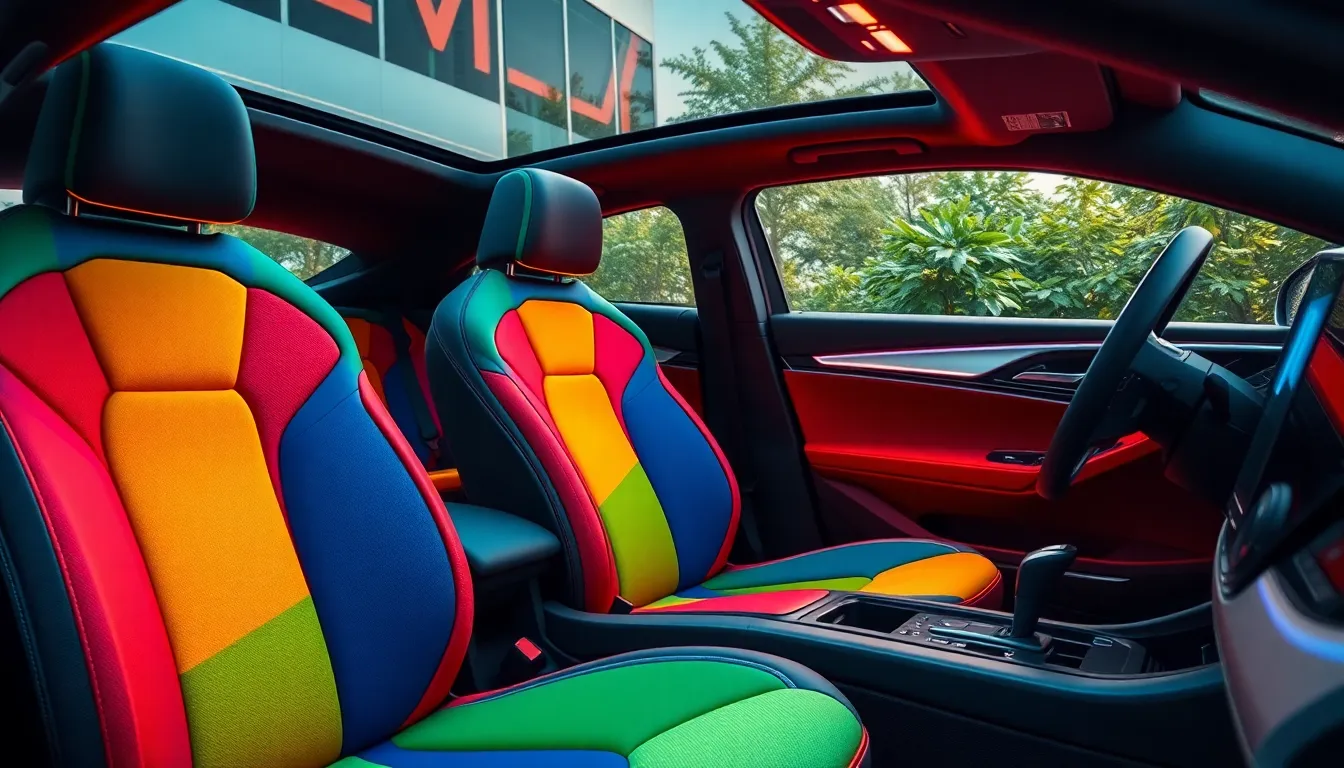
Car seat cover design continues evolving through groundbreaking innovations that combine environmental consciousness with advanced technology. Modern manufacturers prioritize sustainable materials and smart integration features that enhance both driver comfort and vehicle functionality.
Eco-Friendly Materials
Recycled ocean plastic transforms into durable seat cover fabrics that perform exceptionally in automotive environments. Companies like SEAQUAL INITIATIVE convert 27 plastic bottles into materials sufficient for one complete seat cover set. Organic cotton blends offer breathable alternatives to synthetic materials while reducing environmental impact by 35% compared to conventional polyester production.
Hemp-based fabrics deliver remarkable strength with tensile ratings exceeding 2,500 pounds per square inch. Bio-based leather alternatives derived from mushroom mycelium and pineapple leaves provide luxury aesthetics without animal products. Cork fabric integration creates naturally antimicrobial surfaces that resist odors for extended periods.
Bamboo fiber compositions regulate temperature naturally while maintaining softness comparable to traditional cotton. Plant-based foam padding replaces petroleum-derived cushioning materials in premium eco-friendly designs. Water-based adhesives eliminate volatile organic compounds during manufacturing processes.
| Eco-Material Type | Environmental Benefit | Performance Rating |
|---|---|---|
| Recycled Ocean Plastic | Removes 27 bottles per cover set | 8.5/10 durability |
| Organic Cotton | 35% less water usage | 7.8/10 comfort |
| Hemp Fiber | 60% stronger than cotton | 9.2/10 strength |
| Mushroom Leather | Zero animal products | 8.7/10 luxury feel |
Smart Technology Integration
Embedded heating elements distribute warmth evenly across seat surfaces within 90 seconds of activation. Temperature sensors automatically adjust heating levels based on ambient cabin conditions and user preferences. USB charging ports integrate seamlessly into headrest designs without compromising safety requirements.
Memory foam contains phase-change materials that adapt to body temperature for optimal comfort during extended drives. Massage motors provide therapeutic vibration patterns through smartphone app control. Built-in air circulation systems enhance breathability through micro-perforations and hidden ventilation channels.
Antimicrobial nanotechnology coating eliminates 99.9% of bacteria and viruses on contact surfaces. Smart fabrics monitor driver posture and provide gentle alerts through haptic feedback systems. Wireless charging pads embed within seat cushions to power compatible devices during travel.
LED lighting strips offer customizable ambient illumination that syncs with vehicle interior lighting systems. Pressure sensors detect occupant weight and automatically adjust lumbar support levels. Voice-activated controls integrate with vehicle infotainment systems for hands-free seat adjustments.
Choosing the Right Car Seat Cover Design

Selecting the ideal car seat cover design requires balancing personal preferences with practical requirements and financial constraints. We must evaluate multiple factors to ensure our chosen covers deliver optimal performance and value.
Budget Considerations
Car seat cover prices range from $25 for basic universal fits to over $800 for premium custom leather designs. We find that mid-range options between $75-$200 offer the best balance of quality and affordability for most drivers.
Price Ranges by Material Type:
| Material | Budget Range | Durability Rating | Installation Complexity |
|---|---|---|---|
| Polyester Blend | $25-$65 | 3-4 years | Simple |
| Neoprene | $80-$150 | 5-7 years | Moderate |
| Canvas Duck | $90-$180 | 7-10 years | Moderate |
| Synthetic Leather | $120-$250 | 6-8 years | Complex |
| Genuine Leather | $300-$800 | 10-15 years | Professional |
Budget planning becomes easier when we consider the cost per year of use rather than the upfront expense. Premium leather covers at $500 lasting 15 years cost approximately $33 annually while $50 polyester covers lasting 3 years cost nearly $17 per year.
Seasonal sales events like Black Friday and end-of-model-year clearances offer savings of 30-50% on quality covers. We recommend purchasing during these periods to maximize value without compromising on essential features like airbag compatibility and proper fit.
Vehicle-Exact Requirements
Vehicle compatibility determines which cover designs work effectively in our exact cars. We must match cover specifications to our vehicle’s seat configuration, safety systems, and interior layout.
Seat Configuration Matching:
Different vehicles require distinct cover approaches based on seat splitting ratios. Standard configurations include 60/40 splits in most sedans, 40/20/40 arrangements in larger SUVs, and captain’s chair setups in premium vehicles. Custom covers accommodate these splits precisely while universal options often struggle with complex configurations.
Airbag Integration Requirements:
Modern vehicles contain side-impact airbags integrated into seat frames requiring compatible cover designs. We verify airbag locations through our vehicle manual before selecting covers, ensuring breakaway stitching aligns with deployment zones. Ford F-150 models from 2015-2023 feature seat-mounted airbags that require covers with exact breakaway panels positioned 4-6 inches from the seat edge.
Electronic Component Access:
Heated seat controls, massage functions, and power adjustment switches demand covers with precise cutouts or flexible access panels. Luxury vehicles like BMW 5-Series and Mercedes E-Class feature multiple electronic interfaces requiring covers designed for exact model years. We confirm electronic compatibility to maintain full functionality after installation.
Headrest Integration:
Fixed headrests versus adjustable designs affect cover selection significantly. Vehicles with integrated entertainment systems or active headrests need covers accommodating these features without interfering with operation. Tesla Model S headrests contain speakers requiring covers that don’t muffle audio output.
Conclusion
Car seat cover design has evolved into a sophisticated blend of protection functionality and personal expression. We’ve seen how the right material selection and proper fit can transform your vehicle’s interior while ensuring safety standards remain intact.
The market now offers incredible variety from budget-friendly universal options to premium custom-fit designs with smart technology integration. Whether you’re prioritizing eco-friendly materials or seeking luxury features like heated elements and USB ports the choices available today cater to every driver’s needs.
Making the right choice comes down to understanding your exact requirements and matching them with covers that offer the best balance of quality durability and style within your budget range.
Frequently Asked Questions
What are the main benefits of using car seat covers?
Car seat covers protect your vehicle’s original upholstery from wear, spills, and damage while enhancing interior aesthetics. They allow you to personalize your vehicle’s style with various colors, patterns, and materials. Modern covers also offer improved comfort features and can help maintain your car’s resale value by preserving the original seats underneath.
What materials are best for car seat covers?
The best material depends on your needs. Neoprene offers waterproof protection, leather provides premium aesthetics, canvas works for heavy-duty use, and polyester blends are affordable. For breathability, choose mesh or cotton blends. Waterproof options with advanced coatings are ideal for families with children and pets.
What’s the difference between universal and custom-fit car seat covers?
Universal covers are affordable and designed to fit a wide range of vehicles but may require more adjustment during installation. Custom-fit covers are tailored to specific makes and models, offering precise coverage and quicker installation. Custom options typically provide better appearance and functionality but cost more than universal alternatives.
Are car seat covers compatible with airbags?
Yes, many modern car seat covers are designed with airbag compatibility using breakaway stitching that allows proper airbag deployment during accidents. Always look for certification markings and verify compatibility with your specific vehicle’s airbag configuration. Never use covers that interfere with safety systems.
How do I choose the right car seat cover for my vehicle?
Consider your budget ($75-$200 offers the best quality-to-price ratio), vehicle compatibility, and intended use. Check seat configuration, airbag integration, electronic component access, and headrest design. Match cover specifications to your vehicle’s unique features while balancing personal style preferences with practical requirements like durability and maintenance needs.
What are the latest trends in car seat cover design?
Current trends include sustainable materials like recycled ocean plastic and organic cotton blends, smart technology integration with USB charging ports, and advanced comfort features like memory foam with phase-change materials. Antimicrobial coatings, embedded heating elements, and customizable ambient lighting are also gaining popularity among consumers.
How do I maintain and clean different types of car seat covers?
Maintenance varies by material. Machine-washable covers offer easy care, while leather requires specialized cleaners and conditioners. Most synthetic materials can be spot-cleaned with mild detergents. Waterproof covers typically need simple wipe-downs. Always follow manufacturer instructions for cleaning to preserve material integrity and warranty coverage.

